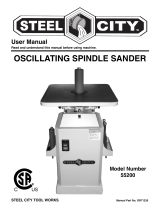
PROBLEM CAUSE SOLUTION
Sander does
not turn on
1. Power cord or extension cord dam-
aged or not properly plugged in.
2. Safety key is removed from power
switch.
3. Defective power switch, defective
motor or wiring, short circuit or loose
connections.
1. Check the power cord, extension cord, power plug
and the power outlet. Make sure the tool is properly
plugged in. Do not use the if any cord is damaged.
2. Insert the safety key into the power switch.
3. Stop using the tool and contact customer service
at (800) 232-1195, M-F 8-5 CST for assistance. Re-
pairs must be done by a qualified technician.
Motor
overheats
1. Motor overloaded.
2. Extension cord too long with an
insufficient gauge.
1. Reduce load on motor - reduce pressure on the
workpiece being sanded.
2. Utilize an extension cord of appropriate gauge and
length or plug tool directly into outlet (see page 8).
Sanding grains
easily rub off
1. Sanding sleeve has been stored in
an incorrect environment.
2. Sanding sleeve has been damaged
or folded.
1. Store sanding accessories away from extremely
hot/dry temperatures.
2. Store sanding accessories flat—not bent or folded.
Deep sand-
ing grooves
or scars in
workpiece.
1. Sanding sleeve grit is too coarse for
the desired finish.
2. Workpiece sanded across the grain.
3. Too much sanding force.
4. Workpiece held still against sanding
surface for too long.
1. Use a finer-grit sanding accessory.
2. Sand with the grain of the wood.
3. Reduce pressure on workpiece while sanding.
4. Keep workpiece moving while sanding on the
sanding sleeve.
Burns on
workpiece
1. Using a sanding grit that is too fine.
2. Using too much pressure.
3. Work held still for too long.
4. Sanding sleeve loaded with debris.
1. Use a coarser-grit sanding accessory.
2. Reduce sanding pressure on workpiece.
3. Do not keep workpiece in one place for too long.
4. Clean or replace the sanding sleeve.
Sanding
surface clogs
quickly
1. Too much pressure against sleeve.
2. Sanding softwood.
1. Clean sanding sleeve. Reduce pressure on work-
piece while sanding.
2. Use different stock/sanding accessories, or accept
that this will happen and plan on cleaning or replac-
ing sleeves frequently.
Sander
vibrates
excessively
or has noisy
operation.
1. Sanding sleeve out of balance or is
loose.
2. Motor or internal components loose.
3. Machine not properly mounted.
4. Faulty motor bearings.
1. Ensure sleeve is properly installed.
2. Inspect/replace damaged bolts/nuts and retighten
with thread-locking fluid.
3. Tighten mounting hardware.
4. Test by rotating shaft; rotational grinding/loose
shaft requires bearing replacement.
Sanding stops
oscillating
Spindle drive belt is broken and re-
quires replacement.
Contact customer service at (800) 232-1195, M-F
8-5 CST for assistance. Repairs must be done by a
qualified technician.
TROUBLESHOOTING GUIDE
WARNING: Stop using the tool immediately if any of the following problems occur. Repairs and
replacements should only be performed by an authorized technician. For any questions, please contact
our customer service at (800) 232-1195, M-F 8-5 CST or email us at techsupport@wenproducts.com.
16





















